

Serial Networks. Optical Transport Network. Ethernet Over Twisted Pair. IEEE 802.3 (Ethernet layer 1&2, MAC of wired Ethernet) Wireless Communication. Wi-fi. IEEE 802.11 ((MAC) and (PHY) spec for WLAN) Bluetooth. IEEE 1394. IEEE 1394 is the High-Definition Audio-Video Network Alliance (HANA) standard connection interface for A/V (audio/visual) component communication and control.[3] FireWire is also available in wireless, fiber optic, and coaxial versions using the isochronous protocols.

History and development[edit] The 6-conductor and 4-conductor alpha FireWire 400 connectors A 9-pin FireWire 800 connector 4-conductor (left) and 6-conductor (right) FireWire 400 alpha connectors A pair of 6-conductor alpha connectors on the edge of an expansion card FireWire is Apple's name for the IEEE 1394 High Speed Serial Bus. Apple intended FireWire to be a serial replacement for the parallel SCSI bus while providing connectivity for digital audio and video equipment. Sony's implementation of the system, i.LINK, used a smaller connector with only four signal conductors, omitting the two conductors that provide power for devices in favor of a separate power connector. IEEE 802.16. IEEE 802.16 is a series of wireless broadband standards written by the Institute of Electrical and Electronics Engineers (IEEE).

The IEEE Standards Board established a working group in 1999 to develop standards for broadband for wireless metropolitan area networks. IEEE 802.15. IEEE 802.15 is a working group of the Institute of Electrical and Electronics Engineers (IEEE) IEEE 802 standards committee which specifies wireless personal area network (WPAN) standards.
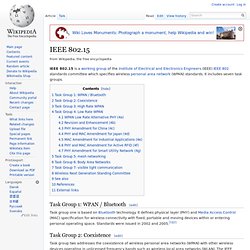
It includes seven task groups. Task Group 1: WPAN / Bluetooth[edit] Task group one is based on Bluetooth technology. It defines physical layer (PHY) and Media Access Control (MAC) specification for wireless connectivity with fixed, portable and moving devices within or entering personal operating space. Standards were issued in 2002 and 2005.[1][2] IEEE 802.3. 802.3 is a technology that supports the IEEE 802.1 network architecture. 802.3 also defines LAN access method using CSMA/CD Communication Standards[edit] See also[edit] References[edit]

Digital subscriber line. Digital subscriber line (DSL; originally digital subscriber loop) is a family of technologies that provide internet access by transmitting digital data using a local telephone network which uses the Public switched telephone network.
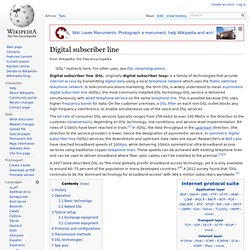
In telecommunications marketing, the term DSL is widely understood to mean asymmetric digital subscriber line (ADSL), the most commonly installed DSL technology. DSL service is delivered simultaneously with wired telephone service on the same telephone line. This is possible because DSL uses higher frequency bands for data. On the customer premises, a DSL filter on each non-DSL outlet blocks any high frequency interference, to enable simultaneous use of the voice and DSL services.
A 2007 book described DSL as "the most globally prolific broadband access technology, yet it is only available to around 60–75 percent of the population in many developed countries. G.hn. G.hn is the common name for a home network technology family of standards developed under the International Telecommunication Union's Telecommunication Standardization sector (the ITU-T) and promoted by the HomeGrid Forum[1] and several other organizations.[2] The G.hn specifications define networking over power lines, phone lines and coaxial cables with data rates up to 1 Gbit/s.[3] ITU-T Recommendation (the ITU's term for standard) G.9960, which received approval on October 9, 2009,[4] specified the physical layers and the architecture of G.hn.
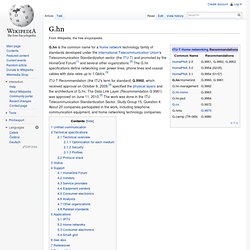
The Data Link Layer (Recommendation G.9961) was approved on June 11, 2010.[5] The work was done in the ITU Telecommunication Standardization Sector, Study Group 15, Question 4. About 20 companies participated in the work, including telephone, communication equipment, and home networking technology companies. Plesiochronous digital hierarchy. The plesiochronous digital hierarchy (PDH) is a technology used in telecommunications networks to transport large quantities of data over digital transport equipment such as fibre optic and microwave radio systems.[1] The term plesiochronous is derived from Greek plēsios, meaning near, and chronos, time, and refers to the fact that PDH networks run in a state where different parts of the network are nearly, but not quite perfectly, synchronised.
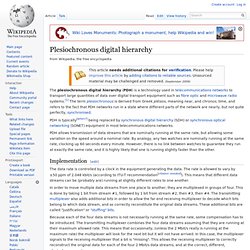
PDH is typically[when?] Being replaced by synchronous digital hierarchy (SDH) or synchronous optical networking (SONET) equipment in most telecommunications networks. PDH allows transmission of data streams that are nominally running at the same rate, but allowing some variation on the speed around a nominal rate. By analogy, any two watches are nominally running at the same rate, clocking up 60 seconds every minute. I.430. I.431. The I.431/430 Networking standards are recommendations produced by the ITU.
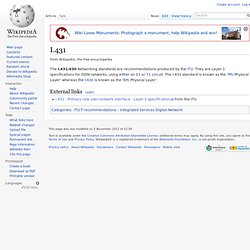
They are Layer 1 specifications for ISDN networks, using either an E1 or T1 circuit. USB. Overview[edit] In general, there are four basic kinds or sizes related to the USB connectors and types of established connections: the older "standard" size, in its USB 1.1/2.0 and USB 3.0 variants (for example, on USB flash drives)the "mini" size (primarily for the B connector end, such as on many cameras)the "micro" size, in its USB 1.1/2.0 and USB 3.0 variants (for example, on most modern cellphones)the versatile "USB On-The-Go" scheme, in both mini and micro sizes.
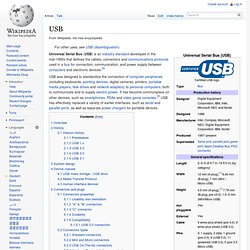
Unlike other data cables (Ethernet, HDMI etc.), each end of a USB cable uses a different kind of connector; an A-type or a B-type. This kind of design was chosen to prevent electrical overloads and damaged equipment, as only the A-type socket provides power. Counter-intuitively, the "micro" size is the most durable from the point of designed insertion lifetime, as the result of latching mechanism (parts providing gripping force) being moved into plugs on the cable side.[5]
List of ITU-T V-series recommendations. The ITU-T V-Series Recommendations on Data communication over the telephone network specify the protocols that govern approved modem communication standards and interfaces.[1] Note: the bis and ter suffixes are ITU-T standard designators of successive iterations of a standard (bis and ter are derived from the Latin for "twice" and "thrice").
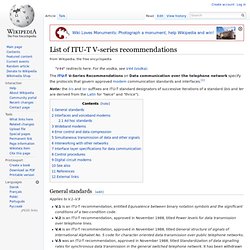
General standards[edit] Applies to V.1–V.9. RS-232. A DB-25 connector as described in the RS-232 standard In telecommunications, RS-232 is a standard for serial communication transmission of data. RS-449. The RS-449 specification, also known as EIA-449 or TIA-449, defines the functional and mechanical characteristics of the interface between data terminal equipment and data communications equipment. The electrical signaling standards intended for use with RS-449 are RS-422 for balanced signals, and RS-423 for the unbalanced signals, with data rates to 2 Mbit/s. The standard specifies DC-37 and DE-9 for the primary and secondary data circuits.
Though never applied on personal computers, this interface is found on some network communication equipment. RS-449. RS-232. 1 & 2. IPS Link Layer (Internet Protocol Suite) Synchronous optical networking. SONET and SDH, which are essentially the same, were originally designed to transport circuit mode communications (e.g., DS1, DS3) from a variety of different sources, but they were primarily designed to support real-time, uncompressed, circuit-switched voice encoded in PCM format.[3] The primary difficulty in doing this prior to SONET/SDH was that the synchronization sources of these various circuits were different. This meant that each circuit was actually operating at a slightly different rate and with different phase. SONET/SDH allowed for the simultaneous transport of many different circuits of differing origin within a single framing protocol. SONET/SDH is not itself a communications protocol per se, but a transport protocol. Due to SONET/SDH's essential protocol neutrality and transport-oriented features, SONET/SDH was the obvious choice for transporting the fixed length Asynchronous Transfer Mode (ATM) frames also known as cells.
Difference from PDH[edit]